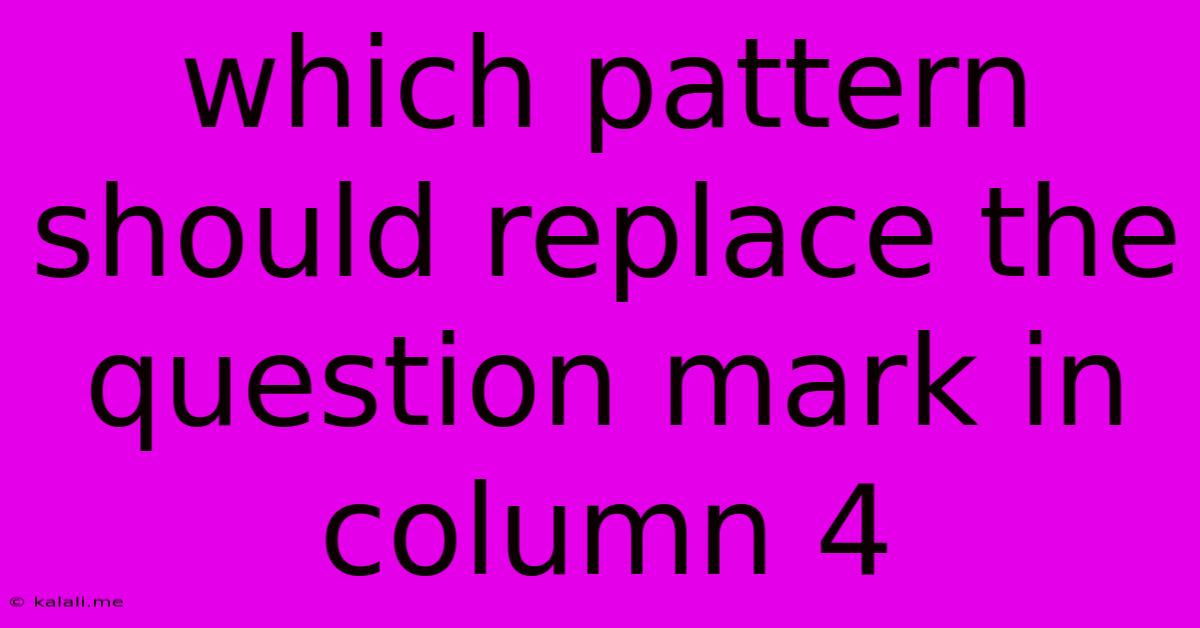Which Pattern Should Replace The Question Mark In Column 4
Kalali
Jun 12, 2025 · 3 min read

Table of Contents
Which Pattern Should Replace the Question Mark in Column 4? A Comprehensive Guide to Pattern Recognition
This article delves into the fascinating world of pattern recognition and logical reasoning. We'll explore how to identify underlying patterns in a sequence and determine the missing element. Specifically, we'll focus on solving puzzles where the task is to find the pattern that should replace the question mark in column 4. Understanding these patterns improves logical thinking skills and is applicable to various fields, from mathematics and programming to problem-solving in everyday life.
Understanding Pattern Recognition Puzzles
Pattern recognition puzzles, often presented as grids or sequences, test your ability to identify underlying rules and relationships between elements. These puzzles require careful observation, analytical thinking, and the ability to extrapolate the identified pattern to predict the missing element. They can involve various types of patterns including:
- Numerical Patterns: Sequences involving numbers, often requiring the identification of arithmetic or geometric progressions.
- Geometric Patterns: Sequences involving shapes, colors, or orientations. These might involve rotations, reflections, or additions/removals of elements.
- Logical Patterns: Sequences where the relationships between elements are less obvious and require more abstract reasoning. This often involves combining multiple patterns or applying logical rules.
Approaching the "Question Mark" Puzzle
To solve a puzzle where you need to find the pattern that should replace the question mark in column 4, follow these steps:
-
Analyze the Provided Data: Carefully examine each row and column. Look for patterns within individual rows, individual columns, and diagonals. Are there numerical progressions, changes in shape, or shifts in color or orientation?
-
Identify Potential Patterns: Once you've observed the elements, start identifying potential patterns. Consider various possibilities – are the elements being added, subtracted, multiplied, or divided? Are there rotations or reflections occurring?
-
Test Your Hypothesis: Once you think you've found a pattern, test it against all existing elements in the grid. Does the pattern consistently explain the relationships between all the elements? If not, revisit step 2 and explore alternative possibilities.
-
Predict the Missing Element: If your hypothesis successfully explains the existing elements, use the identified pattern to predict the element that should replace the question mark in column 4.
-
Verify Your Solution: Double-check your solution. Does it fit seamlessly within the existing pattern? If the answer feels intuitively correct and aligns with the observed patterns, you've likely found the right solution.
Example and Solution Strategies
While a specific puzzle isn't provided, let's explore common solution strategies using hypothetical examples.
Imagine a grid where the pattern involves adding a consecutive number to each element in a row. If row 1 shows 2, 4, 6, then the pattern is adding 2. The next number would be 8.
Another example could involve a geometric pattern with shapes. If a row shows a circle, a square, a triangle, the pattern might involve a progression of simple geometric shapes. The next element could be a rectangle, or another shape depending on the exact nature of the sequence.
Advanced Techniques
For more complex puzzles, you might need to combine multiple patterns. For instance, a pattern might involve adding a number in one column and rotating shapes in another column. Solving these requires a systematic and methodical approach, carefully exploring all possibilities.
Conclusion
Solving puzzles that require identifying the pattern to replace a question mark in column 4 hones your pattern recognition skills. By following the steps outlined in this article, including careful observation, hypothesis testing, and verification, you can confidently tackle these challenges and improve your analytical and problem-solving abilities. Remember that practice is key – the more puzzles you solve, the better you'll become at identifying and predicting complex patterns.
Latest Posts
Latest Posts
-
Which Of The Following Statements Is True About Algorithms
Jun 13, 2025
-
Which Of The Following Is Not True About Minerals
Jun 13, 2025
-
Divide And Conquer Vs Dynamic Programming
Jun 13, 2025
-
Communication Between Two People Is Called
Jun 13, 2025
-
Groups Of Cells That Are Similar In Structure And Function
Jun 13, 2025
Related Post
Thank you for visiting our website which covers about Which Pattern Should Replace The Question Mark In Column 4 . We hope the information provided has been useful to you. Feel free to contact us if you have any questions or need further assistance. See you next time and don't miss to bookmark.